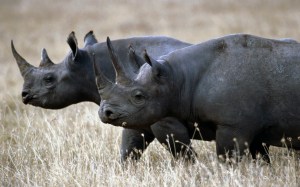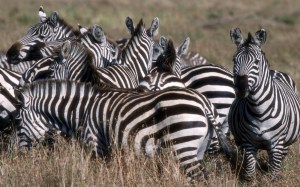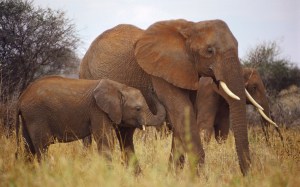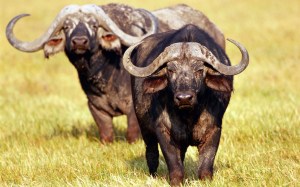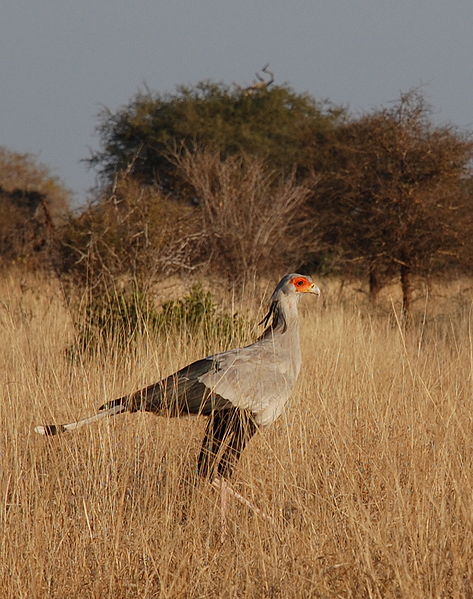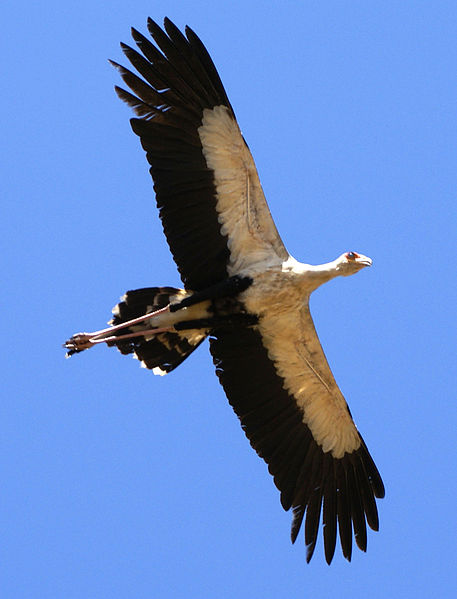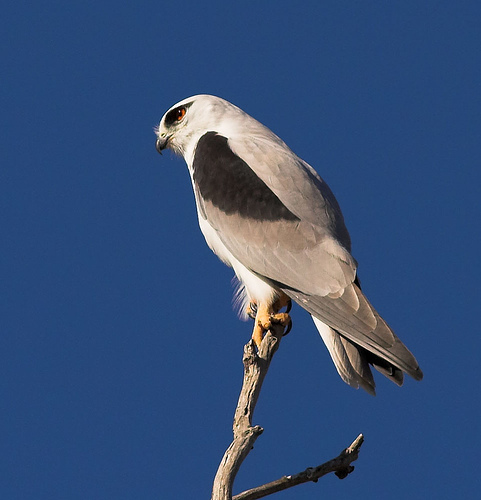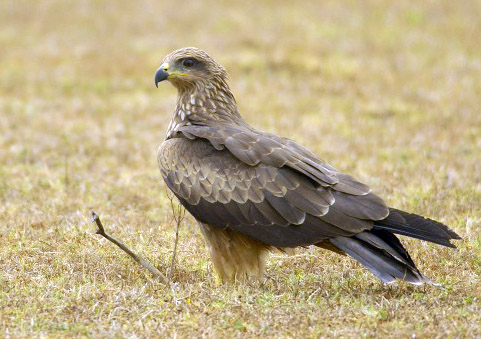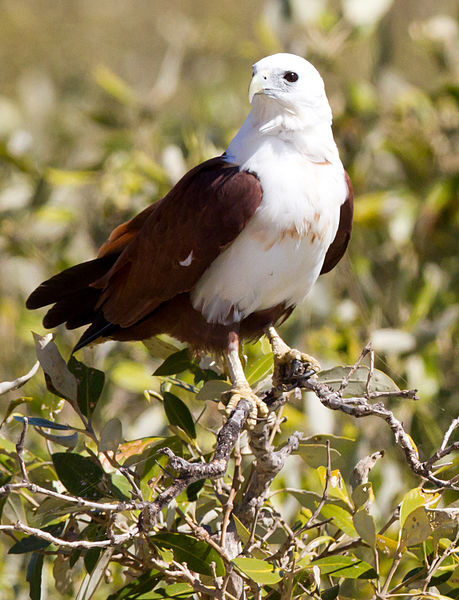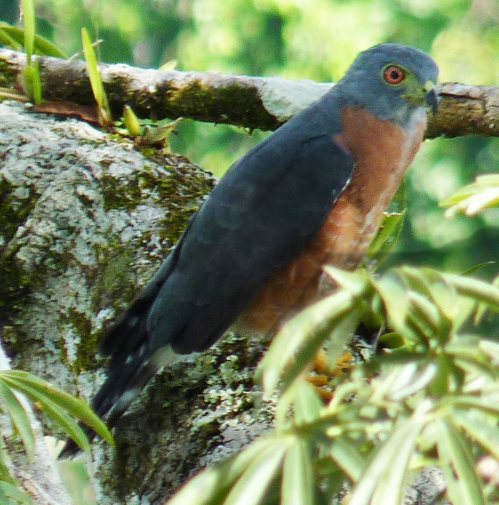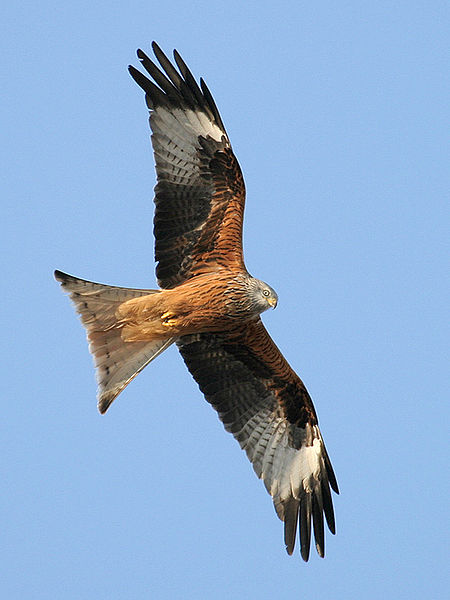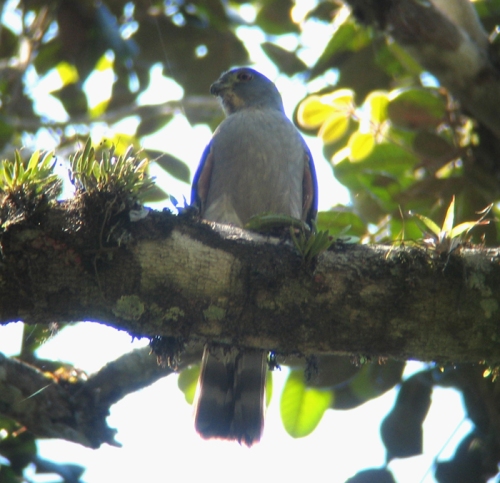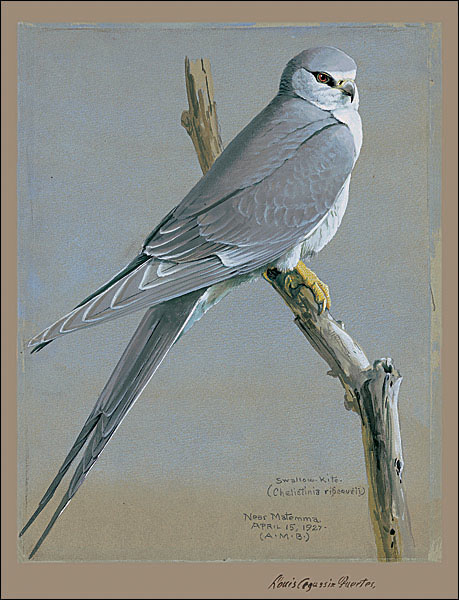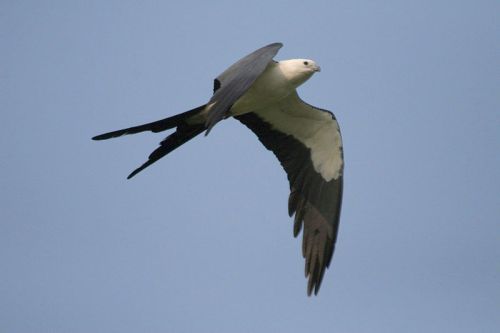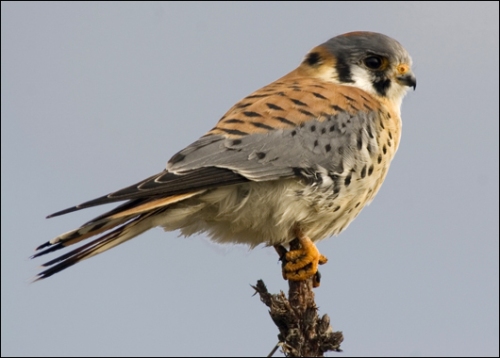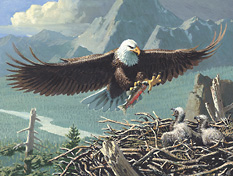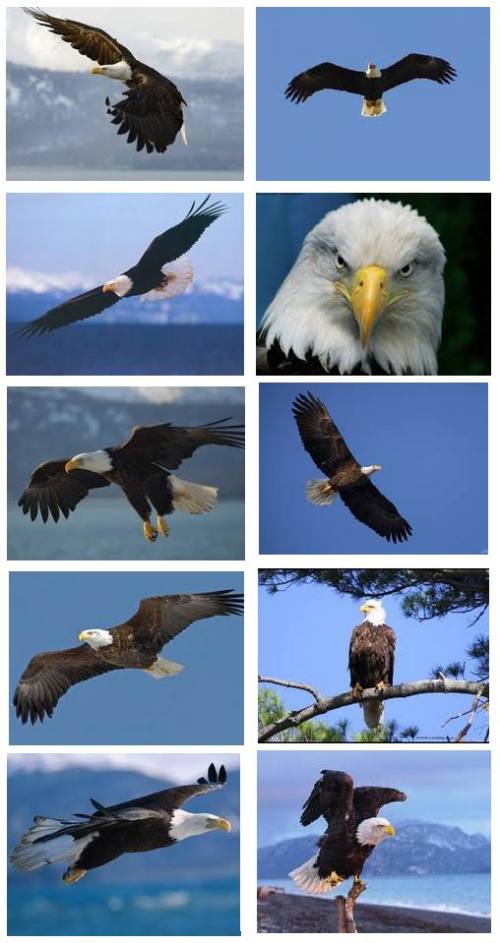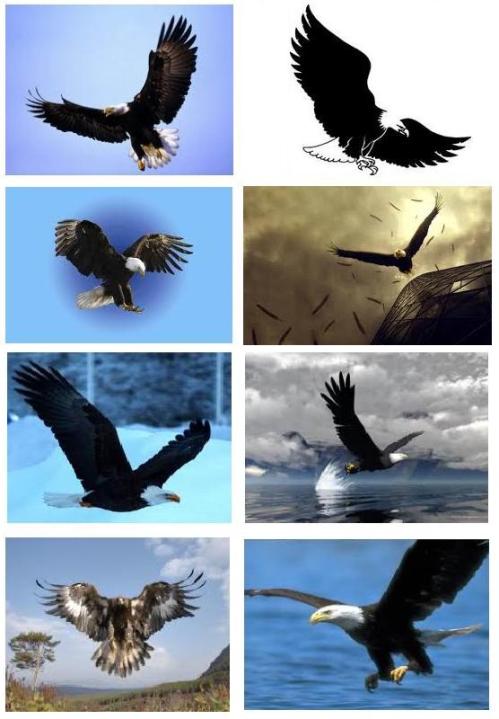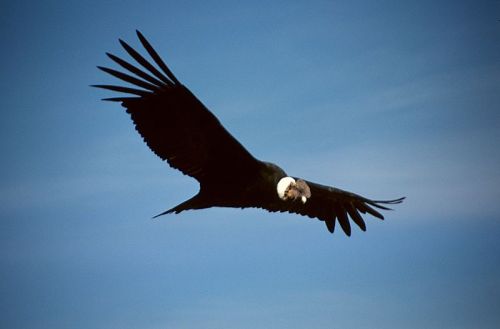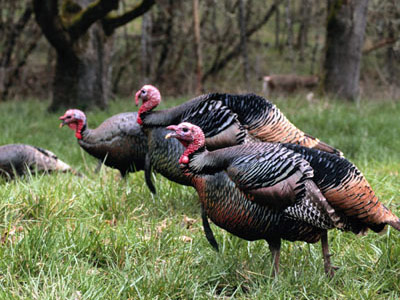Hawk
Hawk, a bird of prey found in most parts of the world. Hawks belong to the same family as eagles and kites and are closely related to falcons, ospreys, and vultures. They have strong talons (claws) for catching and holding prey while they tear the flesh with their sharp, curved beaks. Hawks have powerful wings and keen eyesight. They are swift fliers and can soar for long periods.

Hawks soar high in the air searching for prey.
Hawks vary considerably in size according to the species. The female is usually larger and stronger than the male. Hawks vary in color to some extent, but most are gray or reddish brown on top and whitish underneath. They usually have darker spots or streaks on the neck, breast, and legs and darker bars on the tail and wings. Their legs are feathered, in some species right down to the toes. Usually the bills are black, the feet yellow, and the talons black.
Feeding
Most hawks hunt by day, feeding on smaller birds and land animals. The bat hawk of Asia and Africa, however, hunts bats at night. For many years farmers and hunters killed all hawks on sight to protect poultry and young farm animals, as well as song and game birds. However, it has been found that only a few kinds of hawks harm livestock. The damage they do is far outweighed by their help in ridding farms of such pests as rats, mice, gophers, rabbits, and grasshoppers.

The northern harrier feeds primarily on mice.
What Makes a Hawk a Bird of Prey?
Hawks are another kind of bird of prey. Hawks hunt during the day. So do most other birds of prey—except owls. (Most owls, as you know, hunt at night.) Like owls, hawks have strong legs and feet with sharp, curved talons. They also have powerful beaks for catching and eating prey.
This sharp-shinned hawk is a forest hawk. It has short, rounded wings and a long tail. This hawk can gain speed quickly and make sharp turns. These skills are important in hunting in woods where there are lots of trees.
A sharp-shinned hawk sits on a perch and watches for prey. Then it darts down and pounces. Its long, thin toes and sharp talons are just right for grasping songbirds, which it often catches in flight. This hawk has to eat 1/4 of its body weight each day.
How Do Hawks Care for Their Feathers?
Like all birds of prey, hawks spend time taking care of their flying equipment, which is their feathers. Hawks sometimes bathe by splashing at the edge of a lake or a stream. Or, they may take dust baths to get rid of fleas.
A bird’s feathers are made of a network of straight, thin parts called barbs and parts with tiny hooks called barbules. The barbs and barbules can come apart and get ruffled. Birds smooth their feathers with their beaks. They put the barbs and barbules back together, like fixing a zipper. They spread oil on their feathers to protect and waterproof them. The oil comes from a small gland near the bird’s tail.
Nesting
Hawks build bulky nests of sticks on rocky cliffs or hills, or in trees. A few species nest on the ground. The eggs are whitish or light blue, usually spotted with brown, and are two to seven in number, according to the species. The newly hatched young are covered with white down. They are looked after by both parents for a month or six weeks until they are able to fly.
Hawks of the United States
Hawks found in the United States are divided into the following groups: short-winged hawks, broad-winged hawks, and harriers. All three groups belong to the family Accipitridae. A number of birds belonging to other families are sometimes called hawks. An example is the American sparrow hawk, a member of the falcon family, Falconidae.
Short-winged Hawks,
or Bird Hawks, belong to the genus Accipiter. They have small heads and long tails. They are sometimes called blue darters because of their gray-blue backs and their ability to maneuver in heavily wooded areas. Several species are used in falconry. Three species of short-winged hawks are found in the United States:
The Goshawk,
the largest of the short-winged hawks, is 20 to 24 inches (50 to 60 cm) in length and has a blackish crown, blazing red eyes, and pale-gray underparts. Its name comes from “goose hawk,” for the bird was formerly trained to hunt geese and other game birds. In America the goshawk breeds in the woodlands of Canada and the northern United States, wintering southward into Mexico. Usually three to four bluish-white eggs are laid in a nest of sticks built high in a tall tree.
The goshawk is A. gentilis.

The goshawk has a blackish crown, blazing red eyes, and pale-gray underparts.
Cooper’s Hawk
is 14 to 20 inches (35 to 50 cm) long. The top of its bead is blackish and its breast is reddish brown. It breeds from the woodlands of southern Canada to the Gulf States and northern Mexico, and winters as far south as lower Central America.
Cooper’s hawk is A. cooperii.
The Sharp-shinned Hawk
resembles Cooper’s hawk but is only 10 to 14 inches (25 to 35 cm) long. It ranges over all of North America, breeding south to Florida and northern Mexico and wintering south to Panama.
The sharp-shinned hawk is A. striatus.
Broad-winged Hawks, or Buzzard Hawks,
belong to the genus Buteo. They are noted for their habit of soaring in wide circles. Their tails are broad and rounded. Ten species of broad-winged hawks are found in the United States. They include the following:
The Red-shouldered Hawk
is 18 to 24 inches (45 to 60 cm) long. It is grayish brown on top with rusty-red shoulders, and a paler reddish-gray underneath. There are dark bands across wings and tail. It breeds over most of Canada and the United States south to northern Mexico, wintering in the southern part of its range.
The red-shouldered hawk is B. lineatus.
The Red-tailed Hawk,
19 to 24 inches (48 to 60 cm) long, is dark brown on top, except for the rusty-red tail. The tail is whitish underneath. Red-tailed hawks are whitish on the breast, with brown streaks across the belly. There are subgroups, of phases, of the red-tailed hawk that differ in color from the larger group. One of these is sooty black except for the red tail, another is almost white, and a third is reddish and buff all over. The red-tailed hawk breeds all over North America south to the West Indies.
The red-tailed hawk is B. jamaicensis.
What Is a Buteo?
A buteo (BYOO tee oh) is a soaring hawk. A buteo glides high in the air, using its remarkable eyesight to scan the ground for prey. When a buteo like this red-tailed hawk spots prey, it dives down. It strikes the prey with sharp talons. Then it carries the prey to a perch, where the hawk can eat safely.
Buteos are powerful fliers. They need to be, because their prey include rabbits and pheasants. These animals are heavier than the prey eaten by forest hawks. It takes young buteos a long time to become good hunters.When courting, male buteos do spectacular high flights and dives. A courting pair may hold claws and do cartwheels in the air.
The Rough-legged Hawk
gets its name from the feathers covering the front of its legs. It is 20 to 24 inches (50 to 60 cm) long. Most rough-legged hawks are brown, white, and reddish on top. The whitish breast is streaked with brown, and the white tail has a broad black band at the end. There is a black phase of the rough-legged hawk. The rough-legged hawk breeds in the Arctic and winters from southern Canada to Louisiana and Texas.
The rough-legged hawk is B. lagopus.
Harriers
belong to the genus Circus. They have long, tapered wings and long legs. Of the 10 species of harriers, only one species, the marsh hawk, is found in the United States.


Marsh Hawk
Marsh Hawk, or Northern Harrier, a bird of prey that lives in marshy or grassy areas of North America; it is the only harrier found in the Americas. The bird has long, yellow legs, a long tail, and an owl-like, disc-shaped face. The male, about 20 inches (50 cm) long, has a bluish-gray back, black wingtips, a white rump, and whitish under-parts. The slightly larger female is dark brown with buff streaks.
Marsh hawks hunt while flying close to the ground. They feed chiefly on mice, small birds, frogs, and snakes. Four to six bluish-white eggs are laid in a grass nest built on the ground. The young mature in about two years.
The marsh hawk is Circus cyaneus hudsonius of the hawk family, Accipitridae.





